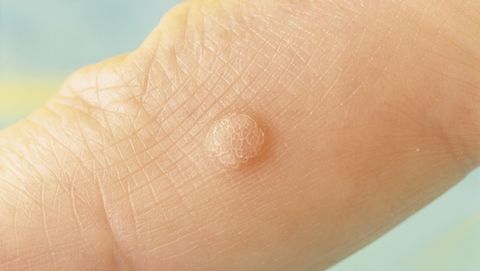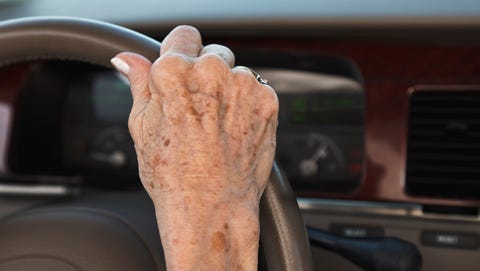9 Weird Skin Spots You Should Definitely Get Checked Out ( courtecy;-
Is that new bump on your skin completely harmless—or something to worry about?
You look at your body in the mirror and something red, brown, or pink is staring back at you—wait, where’d that new spot come from? Of course, your brain jumps to the worst possible conclusion: skin cancer.
But before you freak out, you should know there are lots of causes for a new spot on your skin, and many are completely harmless (even if they are annoying to look at or deal with).
If a new spot turns up, you should still make your dermatologist aware of it, advises Michelle Pelle, MD, dermatologist and medical director at MedDerm Associates in San Diego. This way, you can immediately rule out something more sinister.
Here, a breakdown of all the not-so-serious skin spots (and a couple of concern), how to identify them, and what you can do to return your skin to its former glory.
Cherry Angioma
A cherry angioma can look like a little red bump, though it may lie completely flat on your skin. It’s actually a cluster of dilated blood vessels.
“Patients will come in and say they keep getting more and more,” says Nada Elbuluk, MD, assistant professor in the department of dermatology at NYU Langone Medical Center. “And it’s true, you get them as you age,” she says. They can also run in families—so if your older sister has some, chances are you will, too.
The good news: they’re totally benign. If you want them removed, Dr. Pelle treats them with IPL (intense pulsed light).
Skin Tags
Skin tags are harmless fleshy growths that often pop up in clusters. They can be annoying—especially if they’re located around your bra strap or in a spot that your clothing tends to rub.
That constant friction can make them irritated and inflamed, but if your skin tag is not bothering you, you don’t have to remove it. And if they are? Don’t try to get rid of them yourself by cutting or scraping them off.
“People will use non-sterile tools and come in with inflamed, irritated, and infected skin,” Dr. Elbuluk says. The only safe course is to see your derm, who will either freeze or numb it before snipping it off.
Warts
If you’ve ever dealt with a wart, you know just how stubborn they can be. Warts are actually caused by human papillomavirus, which consists of several strains that can affect various parts of your body (yep, including your genitals.)
The good news is, they’re typically harmless and painless if they appear on other parts of your body, like your hands or face. However, plantar warts can develop on the soles of your feet, which can become painful and interfere with running or walking, since you’re constantly putting pressure on it.
Resist the urge to yank it off yourself, because that just opens the gates for infection. Instead, talk to your derm, who will first perform a biopsy to make sure it’s not skin cancer. Then, he or she can remove it with prescription meds, laser treatment, or by freezing or burning it off. Then, make sure you take these steps to prevent another wart from popping up.
Dermatofibroma
You’ll find a dermatofibroma most often on your arms and legs, and they can be pink or brown. The bump is made up of fibrous scar tissue, which can form as a reaction to something like a bug bite or ingrown hair.
“A patient will come in and tell me that she’s had this bump that’s been on her skin for years and it never goes away,” Dr. Elbuluk says.
Like a skin tag or cherry angioma, these are perfectly harmless. But because it can look like a mole, you’ll want a derm to take a look to determine which one it is, as “moles can change into melanoma, but a dermatofibroma does not,” says Dr. Pelle.
Solar Lentigines
You know them by their more common name: sun spots. They look like a cluster of moles that appear in sun-exposed areas like your arms, face, neck, upper chest, and legs. The good news? While they’re related to how much sun exposure you’ve gotten, they don’t develop into skin cancer, says Dr. Elbuluk.
The bad? They’re hard to tell apart from moles that could turn cancerous. Also, having a lot of them makes it even harder for you to examine your skin yourself—all the more reason to get an annual skin check from a board-certified dermatologist. If they are sun spots, here are 3 ways to get rid of them.
Seborrheic Keratosis
Seborrheic keratosis is a dark, scaly, benign crusty overgrowth of the top layer of your skin, explains Dr. Elbuluk. These are common as you reach middle age and beyond. Your derm can remove them by cutting them off, using liquid nitrogen, or treating them with a laser.
But be warned: “Because it’s benign, insurance won’t cover it unless it’s in a bad spot, like on your collar, and chronically irritated,” Dr. Elbuluk notes.
Tinea Infection
Tinea can look like a small red birthmark or discoloration—almost like a stain on your skin. But these spots are actually a kind of fungal infection, including ringworm and athlete’s foot, according to the National Institutes of Health. Tinea comes in various shapes and sizes, and the kind that infects your skin can spread (and infect other people) or become worse if not treated.
Fortunately, treatment is often as simple as washing the infected area with a prescription soap or shampoo, which your derm can hook you up with.
Basal or Squamous Cell Carcinoma
Yes, this is one of the bad ones—but many people don’t realize there are multiple types of skin cancer, Dr. Elbuluk says. “I’ll ask if someone has ever had skin cancer, and they will tell me, ‘No, just a basal cell.’”
Basal and squamous cell carcinomas are the most common types of skin cancer; more than 3 million people are diagnosed with them each year, according to the American Cancer Society. Unlike a benign mole, they often appear red, scaly, or pearly in appearance. While they’re not as deadly as melanoma, Dr. Elbuluk still recommends telling your derm if a mole looks odd or is growing, changing, or becoming symptomatic (bleeding, itching, etc.).
The best way to keep skin cancer away? Slather on the sunscreen with an SPF of at least 30. You can find a few derm-approved options below.









মন্তব্যসমূহ
একটি মন্তব্য পোস্ট করুন